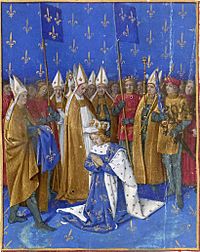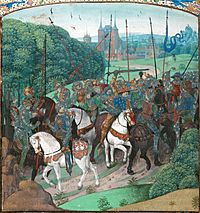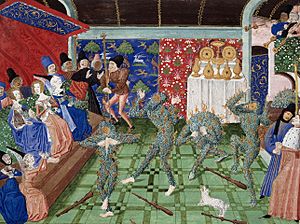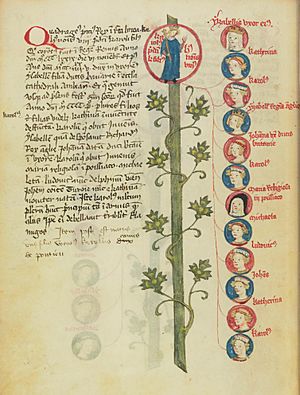Charles VI of France facts for kids
Quick facts for kids Charles VI |
|
|---|---|

Charles VI by the painter
known as the Master of Boucicaut (1412) |
|
| King of France (more...) | |
| Reign | 16 September 1380 – 21 October 1422 |
| Coronation | 4 November 1380 |
| Predecessor | Charles V |
| Successor | Charles VII |
| Regents | |
| Born | 3 December 1368 Paris, Kingdom of France |
| Died | 21 October 1422 (aged 53) Paris, Kingdom of France |
| Burial | 11 November 1422 Saint Denis Basilica |
| Spouse | |
| Issue among others... |
|
| House | Valois |
| Father | Charles V of France |
| Mother | Joanna of Bourbon |
Charles VI (born December 3, 1368 – died October 21, 1422) was the King of France for over 40 years. He was first known as the Beloved (le Bien-Aimé). Later, he became known as the Mad (le Fol) because of his serious mental illness.
Charles became king when he was only eleven years old. At first, his uncles ruled for him as regents. When he grew up, he tried to rule on his own. But then, he started having periods of mental illness. This made it hard for him to govern.
His illness led to big problems in France. Powerful families, like the Orléans and Burgundy families, fought for control. This led to a civil war in France. At the same time, the Hundred Years' War with England was still going on.
In 1415, the English army won a huge battle against France. This forced Charles to sign a treaty. The treaty said that his own son, Charles VII, could not be king. Instead, the English king, Henry V, would become the next king of France. Luckily for France, Henry V died shortly before Charles VI. This gave Charles's son a chance to fight for the throne. Eventually, with the help of Joan of Arc, Charles VII became the true King of France.
Contents
Early Life
Charles was born in Paris on December 3, 1368. His parents were King Charles V and Joanna of Bourbon. As the oldest son, he was the heir to the French throne. This meant he would become king after his father. He also held the title of Dauphin of France.
King of France
Becoming King
Charles became King of France on September 16, 1380, when his father died. He was only 11 years old. His coronation, which is the ceremony where he was officially made king, happened on November 4, 1380, at Reims Cathedral.
The Regents Take Over
Because Charles was so young, his uncles ruled France for him. These rulers were called regents. The main regents were Philip the Bold, Duke of Burgundy, Louis I, Duke of Anjou, and John, Duke of Berry. His mother's brother, Louis II, Duke of Bourbon, was also a regent. Philip the Bold was the most powerful of them.
These regents often spent the kingdom's money for their own benefit. They also brought back taxes that Charles V had removed. This led to some protests from the people. In 1388, when Charles was 20, he decided to take control of the kingdom himself. He brought back his father's trusted advisors. People called him Charles the Beloved at this time.
His Mental Illness
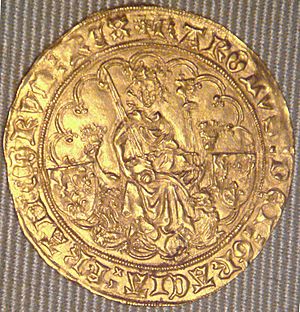
Charles VI's good start as king did not last long. From his mid-twenties, he began to have serious mental health problems. People started calling him Charles the Mad.
His first known episode happened in 1392. He was leading his army when he suddenly attacked his own men. He even killed some of them. After this, he fell into a coma.
His mental illness continued throughout his life. Sometimes, he would forget his name or that he was king. He might not recognize his own wife or children. He would have periods where he was very confused. Sometimes, he would refuse to bathe or change his clothes for months. These episodes made it very difficult for him to rule.
The Ball of the Burning Men
In January 1393, a masked ball was held at the royal palace. Charles and four other lords dressed up as "wild men." Their costumes were made of linen covered in a sticky material and hemp, making them look hairy. During the party, Charles's brother, Louis I, Duke of Orléans, accidentally set one of the costumes on fire with a torch. The flames quickly spread. The Duchess of Berry quickly covered the king with her dress, saving him. But four of the men in costumes died from the fire. This event was very shocking and showed how unstable things were.
Expulsion of the Jews
In 1394, Charles VI ordered all Jews to leave his kingdom. This was a sudden decision. They were given time to sell their belongings and settle their debts before leaving France.
Struggles for Power
Because Charles VI was often ill, his wife, Queen Isabeau of Bavaria, led a council to rule the kingdom. Philip the Bold, Duke of Burgundy, who had been a regent, had a lot of influence. But then, the king's brother, Louis I, Duke of Orléans, also wanted more power. Some people even thought he was the queen's lover.
This led to a big rivalry between Louis d'Orléans and John the Fearless, who became the Duke of Burgundy after his father Philip died. This rivalry grew into a civil war in France. It was called the Armagnac–Burgundian Civil War. The king was often controlled by one side or the other.
The Hundred Years' War Continues
In 1415, the English king, Henry V of England, invaded France. His army crushed the French at the Battle of Agincourt. This was a terrible defeat for France.
Because of this defeat and the ongoing civil war, Charles VI was forced to sign the Treaty of Troyes in 1420. This treaty was very important. It said that Charles's own son, the Dauphin Charles, would not inherit the throne. Instead, Henry V of England would become the next King of France. To seal the deal, Charles VI's daughter, Catherine of Valois, married Henry V.
However, Henry V died just a few weeks before Charles VI in August 1422. This was a huge turning point. It meant that Henry V's infant son, Henry VI, became King of England and, according to the treaty, King of France.
Charles VI died on October 21, 1422, in Paris. He was buried in Saint Denis Basilica.
Charles VII and Joan of Arc
Even though the Treaty of Troyes disinherited him, Charles VI's son, the Dauphin Charles, kept fighting for his right to be king. In 1429, a young woman named Joan of Arc appeared. She led the French forces to important victories against the English. She helped the Dauphin Charles be crowned King Charles VII of France at Reims Cathedral on July 17, 1429.
Charles VII became known as "Charles the Victorious." He continued to fight the English and eventually won the Hundred Years' War in 1453. This brought the French royal family back to full power.
Family Life
Charles VI married Isabeau of Bavaria on July 17, 1385. They had many children together.
| Name | Birth | Death | Notes |
|---|---|---|---|
| Charles, Dauphin | 25 September 1386 | 28 December 1386 | Died very young. |
| Jeanne | 14 June 1388 | 1390 | Died very young. |
| Isabella | 9 November 1389 | 13 September 1409 | Married (1) Richard II, King of England. Married (2) Charles, Duke of Orléans. |
| Jeanne | 24 January 1391 | 27 September 1433 | Married John V, Duke of Brittany. |
| Charles, Dauphin | 6 February 1392 | 13 January 1401 | Died young. |
| Marie | 22 August 1393 | 19 August 1438 | Became an abbess (a leader in a convent). |
| Michelle | 11 January 1395 | 8 July 1422 | Married Philip the Good, Duke of Burgundy. |
| Louis, Dauphin | 22 January 1397 | 18 December 1415 | Died without children. |
| John, Dauphin | 31 August 1398 | 5 April 1417 | Died without children. |
| Catherine | 27 October 1401 | 3 January 1437 | Married (1) Henry V, King of England. Married (?) (2) Owen Tudor. |
| Charles VII of France | 22 February 1403 | 21 July 1461 | Became Charles VII, King of France. Married Marie of Anjou. |
| Philip | 10 November 1407 | November 1407 | Died very young. |
Charles also had a mistress, Odette de Champdivers. They had one daughter:
- Marguerite, bâtarde de France (died around 1458).
Films and Television
- Harcourt Williams in Henry V (1944)
- Paul Scofield in Henry V (1989)
- Lambert Wilson in The Hollow Crown (2012)
- Thibault de Montalembert in The King (2019)
- Alex Lawther in The Last Duel (2021)
See Also
 In Spanish: Carlos VI de Francia para niños
In Spanish: Carlos VI de Francia para niños
- Henry of Marle (died 1418)
- Journal d'un bourgeois de Paris


